6.08.2020
'Shallow Lightning' and 'Mushballs' Reveal Ammonia to NASA's Juno Scientists
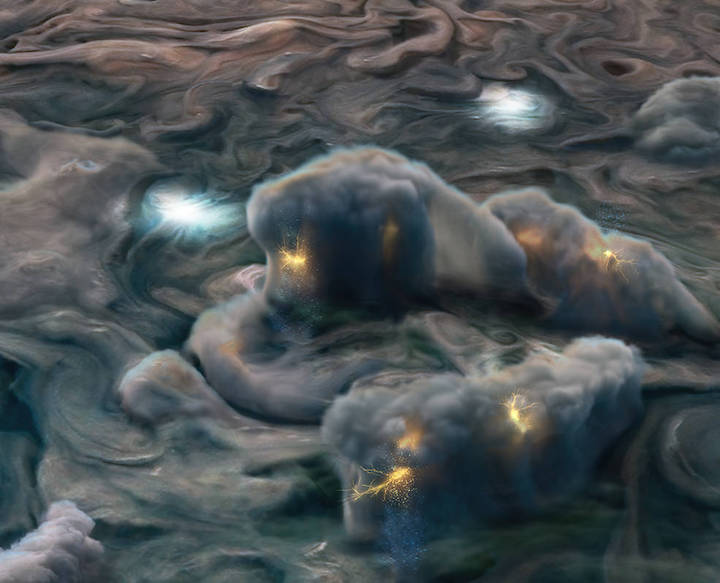
New results from NASA's Juno mission at Jupiter suggest our solar system's largest planet is home to what's called "shallow lightning." An unexpected form of electrical discharge, shallow lightning originates from clouds containing an ammonia-water solution, whereas lightning on Earth originates from water clouds.
Other new findings suggest the violent thunderstorms for which the gas giant is known may form slushy ammonia-rich hailstones Juno's science team calls "mushballs"; they theorize that mushballs essentially kidnap ammonia and water in the upper atmosphere and carry them into the depths of Jupiter's atmosphere.
The shallow-lightning findings will be published Thursday, Aug. 6, in the journal Nature, while the mushballs research is currently available online in the Journal of Geophysical Research: Planets.
Since NASA's Voyager mission first saw Jovian lightning flashes in 1979, it has been thought that the planet's lightning is similar to Earth's, occurring only in thunderstorms where water exists in all its phases – ice, liquid, and gas. At Jupiter this would place the storms around 28 to 40 miles (45 to 65 kilometers) below the visible clouds, with temperatures that hover around 32 degrees Fahrenheit (0 degrees Celsius, the temperature at which water freezes). Voyager saw lightning as bright spots on Jupiter's cloud tops, suggesting that the flashes originated in deep water clouds. But lightning flashes observed on Jupiter's dark side by Juno's Stellar Reference Unit tell a different story.
"Juno's close flybys of the cloud tops allowed us to see something surprising – smaller, shallower flashes – originating at much higher altitudes in Jupiter's atmosphere than previously assumed possible," said Heidi Becker, Juno's Radiation Monitoring Investigation lead at NASA's Jet Propulsion Laboratory in Southern California and the lead author of the Nature paper.
Becker and her team suggest that Jupiter's powerful thunderstorms fling water-ice crystals high up into the planet's atmosphere, over 16 miles (25 kilometers) above Jupiter's water clouds, where they encounter atmospheric ammonia vapor that melts the ice, forming a new ammonia-water solution. At such lofty altitude, temperatures are below minus 126 degrees Fahrenheit (minus 88 degrees Celsius) – too cold for pure liquid water to exist.
"At these altitudes, the ammonia acts like an antifreeze, lowering the melting point of water ice and allowing the formation of a cloud with ammonia-water liquid," said Becker. "In this new state, falling droplets of ammonia-water liquid can collide with the upgoing water-ice crystals and electrify the clouds. This was a big surprise, as ammonia-water clouds do not exist on Earth."
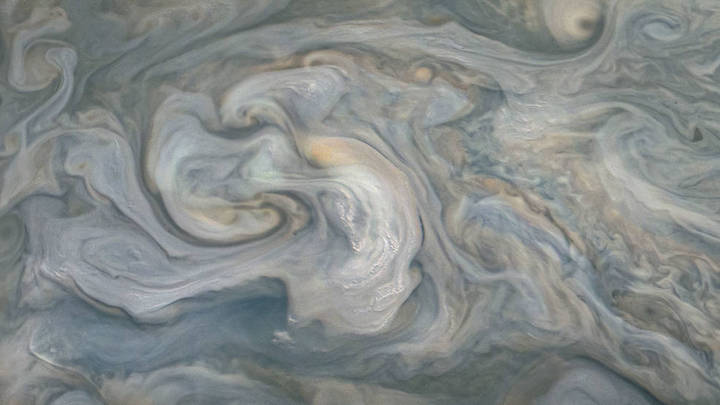
The shallow lightning factors into another puzzle about the inner workings of Jupiter's atmosphere: Juno's Microwave Radiometer instrument discovered that ammonia was depleted – which is to say, missing – from most of Jupiter's atmosphere. Even more puzzling was that the amount of ammonia changes as one moves within Jupiter's atmosphere.
"Previously, scientists realized there were small pockets of missing ammonia, but no one realized how deep these pockets went or that they covered most of Jupiter," said Scott Bolton, Juno's principal investigator at the Southwest Research Institute in San Antonio. "We were struggling to explain the ammonia depletion with ammonia-water rain alone, but the rain couldn't go deep enough to match the observations. I realized a solid, like a hailstone, might go deeper and take up more ammonia. When Heidi discovered shallow lightning, we realized we had evidence that ammonia mixes with water high in the atmosphere, and thus the lightning was a key piece of the puzzle."
Jovian Mushballs
A second paper, released yesterday in the Journal of Geophysical Research: Planets, envisions the strange brew of 2/3 water and 1/3 ammonia gas that becomes the seed for Jovian hailstones, known as mushballs. Consisting of layers of water-ammonia slush and ice covered by a thicker water-ice crust, mushballs are generated in a similar manner as hail is on Earth – by growing larger as they move up and down through the atmosphere.
"Eventually, the mushballs get so big, even the updrafts can't hold them, and they fall deeper into the atmosphere, encountering even warmer temperatures, where they eventually evaporate completely," said Tristan Guillot, a Juno co-investigator from the Université Côte d'Azur in Nice, France, and lead author of the second paper. "Their action drags ammonia and water down to deep levels in the planet's atmosphere. That explains why we don't see much of it in these places with Juno's Microwave Radiometer."
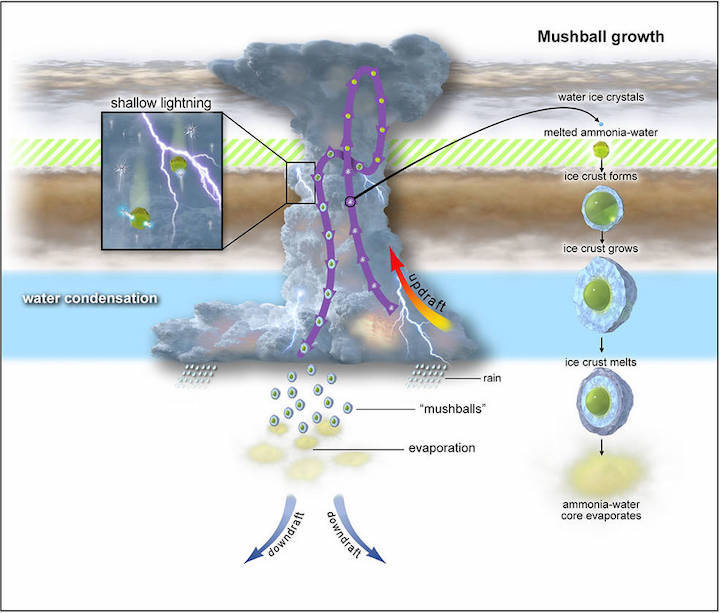
"Combining these two results was critical to solving the mystery of Jupiter's missing ammonia," said Bolton. "As it turned out, the ammonia isn't actually missing; it is just transported down while in disguise, having cloaked itself by mixing with water. The solution is very simple and elegant with this theory: When the water and ammonia are in a liquid state, they are invisible to us until they reach a depth where they evaporate – and that is quite deep."
Understanding the meteorology of Jupiter enables us to develop theories of atmospheric dynamics for all the planets in our solar system as well as for the exoplanets being discovered outside our solar system. Comparing how violent storms and atmospheric physics work across the solar system allows planetary scientists to test theories under different conditions.
More About the Mission
The solar-powered Jupiter explorer launched nine years ago today, on Aug. 5, 2011. And last month marked the fourth anniversary of its arrival at Jupiter. Since entering the gas giant's orbit, Juno has performed 27 science flybys and logged over 300 million miles (483 million kilometers).
JPL, a division of Caltech in Pasadena, California, manages the Juno mission for the principal investigator, Scott Bolton, of the Southwest Research Institute in San Antonio. Juno is part of NASA's New Frontiers Program, which is managed at NASA's Marshall Space Flight Center in Huntsville, Alabama, for the agency's Science Mission Directorate in Washington. Lockheed Martin Space in Denver built and operates the spacecraft.
Quelle: NASA
----
Update: 11.09.2020
.
NASA’s Juno spacecraft seeking extended mission at Jupiter
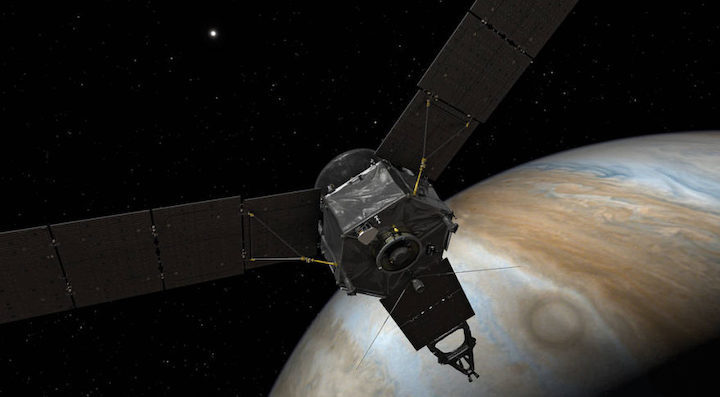
WASHINGTON — NASA’s Juno mission orbiting Jupiter is seeking a long-term extension that would allow the spacecraft to carry out new studies of the planet and some of its largest moons.
Juno, part of the New Frontiers class of medium-sized planetary science spacecraft, is finalizing a proposal for an extended mission that would keep the spacecraft operating through September 2025, said Scott Bolton, principal investigator for Juno, at a Sept. 2 meeting of the Outer Planets Assessment Group online.
Juno has been in orbit around Jupiter since July 2016 on a prime mission of 34 orbits currently scheduled to end in July 2021. That mission is devoted to studying the giant planet’s gravity and magnetic fields in order to better understand its interior.
An extended mission will be more comprehensive. “It really becomes a full system explorer, not as focused as the prime mission was,” Bolton said.
Scientists plan to take advantage of the spacecraft’s gradually shifting orbit around Jupiter. Juno is in an elliptical orbit with a 53-day period whose closest point, or perijove, to Jupiter was initially around the planet’s equator. That perijove has been gradually shifting north, and at the end of the prime mission will be at a latitude of 28 degrees north. That migration will continue through the extended mission, reaching 63 degrees north.
“This gives us close proximity to the northern parts of Jupiter, which is a new frontier,” he said. That includes studies of the aurora seen in the polar regions. “We’ve seen a lot of activity there, and we’ll be able to explore it very close up, whereas in the primary mission we were restricted to the lower latitudes.”
Juno’s shifting orbit will also sweep through the orbits of three of Jupiter’s largest moons: Ganymede, Europa and Io. “The satellites get into view for us and allows close flybys,” he said. Those flybys in the current proposal include a pass 1,000 kilometers from Ganymede in mid-2021 and another just 320 kilometers from Europa in late 2022.
The spacecraft will use its instruments to study the moons. Europa is of particular interest because the icy moon likely has a subsurface ocean of liquid water and may be habitable. Bolton said Juno’s flybys can help measure the thickness of Europa’s outer ice layer and also search for plumes of icy material emitted from the surface.
That would allow Juno to complement future missions to Jupiter, notably NASA’s Europa Clipper and the European Space Agency’s Jupiter Icy Moons Explorer, or JUICE. Observations of Io, the volcanic larger inner moon of Jupiter, would also benefit the proposed Io Volcano Observer mission, one of four finalists in the latest, ongoing round of the Discovery program of low-cost planetary science missions.
Bolton said another aspect of the changing orbit will be observations of Jupiter’s tenuous rings. “There’s been very few images of, and science done on, Jupiter’s rings,” he said. That will include characterizing how material in the rings clumps together.
The proposal is still being finalized, Bolton said, and is due to NASA at the end of the month. He expected the agency to decide on whether to proceed with an extended mission by the end of the year. “It may be limited by the available budget,” he cautioned.
Juno’s mission has already been extended because of concerns with the spacecraft’s main engine, which was originally designed to move the spacecraft from an initial orbit with a period of 53 days to a 14-day orbit. NASA elected to keep Juno in that 53-day orbit, which still allowed it to perform its planned science, but required stretching out the prime mission so that Juno could complete the same number of orbits.
Quelle: SN
+++
Juno and the case of Jupiter’s missing ammonia
NASA’s Juno spacecraft, the agency’s flagship mission to Jupiter, continues to stream back an incredible amount of scientific data about the largest planet in our solar system just over four years after arriving in orbit.
Some of the most recent discoveries pertain to lightning in Jupiter’s upper atmosphere, called “shallow lightning,” as well as indications of ammonia laden hail, which has helped scientists explain the ammonia loss in Jupiter’s upper atmosphere that has puzzled them for some time.
NASA’s Juno spacecraft began its journey to the giant of our solar system in August 2011, launching aboard a United Launch Alliance Atlas V rocket from the Cape Canaveral Air Force Station, Fl.
After a five-year journey, the craft entered orbit of Jupiter on 5 July 2016 (UTC) for a multi-year mission to peer into Jupiter’s atmosphere and provide global scientific coverage of the planet.
Lightning in Jupiter’s atmosphere was first observed during the two Voyager flyby missions in 1979, at which point it was believed the lightning was triggered in a similar manner as on Earth, occurring only in storms where water is present in all three of its phases.
Subsequent observations by other flyby crafts and NASA’s in-situ Galileo probe did not return any findings that would alter this theory. All spacecraft observations of lightning at Jupiter until Juno saw bright spots in Jupiter’s clouds, suggesting an origination point deep within water clouds about 45 to 65 kilometers below the visible cloud surface.
But Juno is, in part, changing our understanding of how Jovian lightning can be triggered and how it illuminates a process unfolding in Jupiter’s upper atmosphere that has held scientists’ curiosity for years.
Dissecting information from the Stellar Reference Unit onboard Juno — which observed lightning flashes on Jupiter’s dark side — revealed the presence of “shallow lightning,” which forms in clouds that contain ammonia-water solutions whereas lightning observed on Earth originates from water.
The Juno data indicates that Jupiter’s water-based thunderstorms fling water-ice crystals 25 km above the water clouds into an area rich with ammonia, where the ammonia melts the ice and forms an ammonia-water solution.
While liquid water in a pure form cannot exist at that altitude, as the temperatures are roughly -88℃, an ammonia-water solution can remain liquid.
“At these altitudes, the ammonia acts like an antifreeze, lowering the melting point of water ice and allowing the formation of a cloud with ammonia-water liquid,” said Heidi Becker, Juno’s Radiation Monitoring Investigation lead at NASA’s Jet Propulsion Laboratory in Southern California.
“In this new state, falling droplets of ammonia-water liquid can collide with the upgoing water-ice crystals and electrify the clouds. This was a big surprise, as ammonia-water clouds do not exist on Earth.”
But in Juno’s case, the spacecraft’s close flyby of the upper atmosphere and clouds revealed flashes of lightning originating at much higher altitudes than previously observed or thought possible.
That triggered an investigation and deep dive into Juno’s data.
“When Heidi discovered shallow lightning, we realized we had evidence that ammonia mixes with water high in the atmosphere,” noted Scott Bolton, Juno’s principal investigator at the Southwest Research Institute in San Antonio.
It is this part that turned out to be key to solving a larger puzzle scientists have been scratching their heads over.

Artist’s impression of shallow lightning in Jupiter’s upper atmosphere. (Credit: NASA/JPL-Caltech/SwRI/MSSS/Gerald Eichstädt/Heidi N. Becker/Koji Kuramura)
The amount of ammonia in Jupiter’s upper atmosphere is not what it should be; in fact, most of it is missing. But ammonia can’t just disappear; something had to be removing it. But what?
“Previously, scientists realized there were small pockets of missing ammonia, but no one realized how deep these pockets went or that they covered most of Jupiter,” said Bolton. “We were struggling to explain the ammonia depletion with ammonia-water rain alone, but the rain couldn’t go deep enough to match the observations.”
Even more curious, the amount of ammonia in the upper atmosphere changes at a specific spot as that spot moves with Jupiter’s rotation. Yet scientists could never explain how all this ammonia was missing — until the discovery of shallow lightning.
While ammonia-rain couldn’t solely explain the ammonia loss from the upper atmosphere, hail could.
“I realized a solid, like a hailstone, might go deeper and take up more ammonia,” added Bolton.
The theory now generated by Juno data — in conjunction with the shallow lightning discovery — is that Jovian thunderstorms form slushy ammonia-rich hailstones called “mushballs” by the science team.
These mushballs trap ammonia and water as they form and then carry the ammonia deep down into Jupiter’s atmosphere — far enough and frequent enough to explain the observed ammonia loss.
An independent investigation of this concluded that the hailstones are roughly ⅔ water and ⅓ ammonia and form in much the same way water hail does on Earth, “by growing larger as they move up and down through the atmosphere,” according to a NASA release on the discovery.
“Eventually, the mushballs get so big, even the updrafts can’t hold them, and they fall deeper into the atmosphere, encountering even warmer temperatures, where they eventually evaporate completely,” said Tristan Guillot, a Juno co-investigator from the Université Côte d’Azur in Nice, France.

The evolutionary process of shallow lightning and mushballs on Jupiter. (Credit: NASA/JPL-Caltech/SwRI/CNRS)
“Their action drags ammonia and water down to deep levels in the planet’s atmosphere. That explains why we don’t see much of it in these places with Juno’s Microwave Radiometer.”
Understanding the relationship between Jupiter’s ammonia and water interaction in the upper atmosphere and what can drive the formation of lightning not only helps planetary scientists better understand the dynamics of our home solar system, but also helps explain atmospheric dynamics on exoplanets.
What’s more, understanding how something that should be present is stripped away from certain levels of planetary atmospheres illuminates how the same basic processes that occur here on Earth with just water can likewise occur with a different liquid medium in place.
This kind of connection between processes on Earth and how they could occur elsewhere with or without water can potentially be seen in our search for life in other places in the solar system. Saturn’s moon Titan has an abundance of liquid methane — which like water could be a primordial breeding ground for life on that moon.
However, it is the connection between the shallow lightning discovery and how it enabled teams to solve a seemingly unconnected mystery that is the truly exciting element as it highlights the interconnected nature of planetary exploration and the suite of instruments the robotic fleet operating throughout the solar system carries.
“Combining these two results was critical to solving the mystery of Jupiter’s missing ammonia,” said Bolton. “As it turned out, the ammonia isn’t actually missing; it is just transported down while in disguise, having cloaked itself by mixing with water.”
“The solution is very simple and elegant with this theory: When the water and ammonia are in a liquid state, they are invisible to us until they reach a depth where they evaporate — and that is quite deep.”
Juno’s mission at Jupiter will continue for 10 more months until 30 July 2021 when controllers will command the craft into a destructive entry into the planet’s atmosphere to prevent it from accidentally colliding with and contaminating one of the potentially life-harboring Jovian moons.
Jupiter’s intense radiation field and its degrading effects on Juno’s radiation-hardened equipment make a mission extension beyond July 2021 unlikely, but scientists have proposed one.
(Lead image: Juno performing a correction burn at Jupiter. Credit: Nathan Koga for NSF/L2
Quelle: NS
----
Update: 26.09.2020
.
Solving the Strange Storms on Jupiter
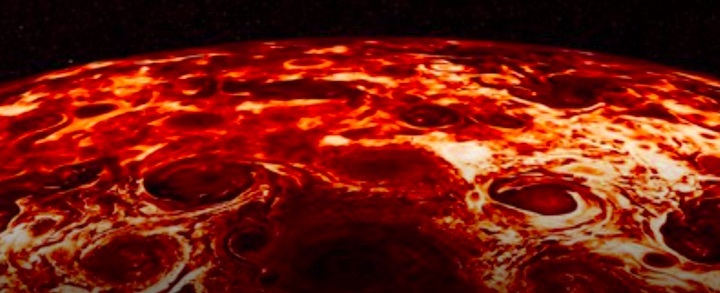
At the south pole of Jupiter lurks a striking sight—even for a gas giant planet covered in colorful bands that sports a red spot larger than the earth. Down near the south pole of the planet, mostly hidden from the prying eyes of humans, is a collection of swirling storms arranged in an unusually geometric pattern.
Since they were first spotted by NASA's Juno space probe in 2019, the storms have presented something of a mystery to scientists. The storms are analogous to hurricanes on Earth. However, on our planet, hurricanes do not gather themselves at the poles and twirl around each other in the shape of a pentagon or hexagon, as do Jupiter's curious storms.
Now, a research team working in the lab of Andy Ingersoll, Caltech professor of planetary science, has discovered why Jupiter's storms behave so strangely. They did so using math derived from a proof written by Lord Kelvin, a British mathematical physicist and engineer, nearly 150 years ago.
Ingersoll, who was a member of the Juno team, says Jupiter's storms are remarkably similar to the ones that lash the East Coast of the United States every summer and fall, just on a much larger scale.
"If you went below the cloud tops, you would probably find liquid water rain drops, hail, and snow," he says. "The winds would be hurricane-force winds. Hurricanes on Earth are a good analog of the individual vortices within these arrangements we see on Jupiter, but there is nothing so stunningly beautiful here."
As on Earth, Jupiter's storms tend to form closer to the equator and then drift toward the poles. However, Earth's hurricanes and typhoons dissipate before they venture too far from the equator. Jupiter's just keep going until they reach the poles.
"The difference is that on the earth hurricanes run out of warm water and they run into continents," Ingersoll says. Jupiter has no land, "so there's much less friction because there's nothing to rub against. There's just more gas under the clouds. Jupiter also has heat left over from its formation that is comparable to the heat it gets from the sun, so the temperature difference between its equator and its poles is not as great as it is on Earth."
However, Ingersoll says, this explanation still does not account for the behavior of the storms once they reach Jupiter's south pole, which is unusual even compared to other gas giants. Saturn, which is also a gas giant, has one enormous storm at each of its poles, rather than a geometrically arranged collection of storms.
The answer to the mystery of why Jupiter has these geometric formations and other planets do not, Ingersoll and his colleagues discovered, could be found in the past, specifically in work conducted in 1878 by Alfred Mayer, an American physicist, and Lord Kelvin. Mayer had placed floating circular magnets in a pool of water and observed that they would spontaneously arrange themselves into geometric configurations, similar to those seen on Jupiter, with shapes that depended on the number of magnets. Kelvin used Mayer's observations to develop a mathematical model to explain the magnets' behavior.
"Back in the 19th century, people were thinking about how spinning pieces of fluid would arrange themselves into polygons," Ingersoll says. "Although there were lots of laboratory studies of these fluid polygons, no one had thought of applying that to a planetary surface."
To do so, the research team used a set of equations known as the shallow-water equations to build a computer model of what might be happening on Jupiter, and began to run simulations.
"We wanted to explore the combination of parameters that makes these cyclones stable," says Cheng Li (Phd '17), lead author and 51 Pegasi b postdoctoral fellow at UC Berkeley. "There are established theories that predict that cyclones tend to merge at the pole due to the rotation of the planet and that's what we found in the initial trial runs."
Eventually, however, the team found that a Jupiter-like stable geometric arrangement of storms would form if the storms were each surrounded by a ring of winds that turned in the opposite direction from the spinning storms, or a so-called anticyclonic ring. The presence of anticyclonic rings causes the storms to repel each other, rather than merge.
Ingersoll says the research could help scientists better understand how weather on Earth behaves.
"Other planets provide a much wider range of behaviors than what you see on Earth," he says, "so you study the weather on other planets in order to stress-test your theories."
The paper, titled, "Modeling the Stability of Polygonal Patterns of Vortices at the Poles of Jupiter as Revealed by the Juno Spacecraft," appears in the September 8 Issue of the Proceedings of the National Academy of Sciences. Co-authors are Cheng Li of UC Berkeley, and Harriet Brettle (MS '19) and undergraduate student Alexandra Klipfel, both of Caltech.
Quelle: Caltech


